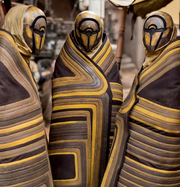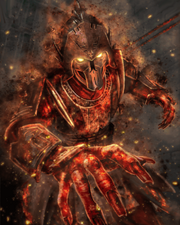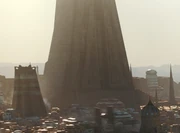GokūBlack10 (talk | contribs) |
GokūBlack10 (talk | contribs) No edit summary |
||
| Line 19: | Line 19: | ||
Their ancient [[dark side]] enemies, the [[Sith]], were later born from a schism in the Order led by an [[unidentified rogue Jedi]] during the [[Hundred-Year Darkness]].<ref name="SW9">[[Star Wars (2015) 9|''Star Wars 9'']]</ref> Conflict between these two Force religions would lead to [[Jedi–Sith war|countless wars]] that resulted in the [[Theocracy/Canon|theocratic]] [[Sith Empire]] in control of the galaxy. However, ultimately, the [[Jedi]] defeated their enemies and thought them to be extinct.<ref name="Propaganda">''[[Star Wars Propaganda: A History of Persuasive Art in the Galaxy]]''</ref> Afterwards, the [[Galactic Republic]] sought to scrub history clean of all mentions of the Sith religion,<ref name="TROSVD"/> even forbidding [[protocol droid]]s from translating their [[Ur-Kittât|runic language]].<ref name="Episode IX">[[Star Wars: Episode IX The Rise of Skywalker|''Star Wars'' Episode IX ''The Rise of Skywalker'']]</ref> However, the [[Sith Lord]] [[Darth Bane]] carried on the Sith religion in the form of the [[Rule of Two]], allowing it to survive its supposed extinction.<ref name="Sacrifice"/> |
Their ancient [[dark side]] enemies, the [[Sith]], were later born from a schism in the Order led by an [[unidentified rogue Jedi]] during the [[Hundred-Year Darkness]].<ref name="SW9">[[Star Wars (2015) 9|''Star Wars 9'']]</ref> Conflict between these two Force religions would lead to [[Jedi–Sith war|countless wars]] that resulted in the [[Theocracy/Canon|theocratic]] [[Sith Empire]] in control of the galaxy. However, ultimately, the [[Jedi]] defeated their enemies and thought them to be extinct.<ref name="Propaganda">''[[Star Wars Propaganda: A History of Persuasive Art in the Galaxy]]''</ref> Afterwards, the [[Galactic Republic]] sought to scrub history clean of all mentions of the Sith religion,<ref name="TROSVD"/> even forbidding [[protocol droid]]s from translating their [[Ur-Kittât|runic language]].<ref name="Episode IX">[[Star Wars: Episode IX The Rise of Skywalker|''Star Wars'' Episode IX ''The Rise of Skywalker'']]</ref> However, the [[Sith Lord]] [[Darth Bane]] carried on the Sith religion in the form of the [[Rule of Two]], allowing it to survive its supposed extinction.<ref name="Sacrifice"/> |
||
| − | |||
| ⚫ | The ancient Jedi also fought a religious [[civil war]] with a splinter group, the [[Ordu Aspectu]], who disagreed with the orthodox members of the Order over the violence they perceived was perpetrated by the Jedi. Galactic [[historian]]s differ on what ultimately caused the conflict between the two sects of the Jedi Order, but, in the end, the rogue Jedi [[Rur]] and his followers were wiped out by the orthodox Jedi.<ref name="Aphra2"/> |
||
[[File:Temple of the Whills - RO trailer.png|left|thumb|The Temple of the Kyber: a holy site in the Holy City on Jedha.]] |
[[File:Temple of the Whills - RO trailer.png|left|thumb|The Temple of the Kyber: a holy site in the Holy City on Jedha.]] |
||
| ⚫ | The ancient Jedi also fought a religious [[civil war]] with a splinter group, the [[Ordu Aspectu]], who disagreed with the orthodox members of the Order over the violence they perceived was perpetrated by the Jedi. Galactic [[historian]]s differ on what ultimately caused the conflict between the two sects of the Jedi Order, but, in the end, the rogue Jedi [[Rur]] and his followers were wiped out by the orthodox Jedi.<ref name="Aphra2"/> |
||
| + | |||
Around the same time, more than 5000 years before the [[Galactic Civil War]], the holy city of [[NiJedha]] was built on the [[moon]] of [[Jedha]].<ref name="Atlas">''[[Star Wars: Galactic Atlas]]''</ref> The city hosted the [[Temple of the Kyber]] and came to be a site of pilgrimage for a plethora of Force religions. The Jedi Order eventually established itself on Jedha, as well, taking up in the Temple of the Kyber.<ref name="R1Novel"/> Despite its religious pluralism, the moon became so associated with the Jedi that it was proposed by historians as a possible location for the [[First Jedi Temple|first Jedi temple]].<ref name="TLJVD"/> |
Around the same time, more than 5000 years before the [[Galactic Civil War]], the holy city of [[NiJedha]] was built on the [[moon]] of [[Jedha]].<ref name="Atlas">''[[Star Wars: Galactic Atlas]]''</ref> The city hosted the [[Temple of the Kyber]] and came to be a site of pilgrimage for a plethora of Force religions. The Jedi Order eventually established itself on Jedha, as well, taking up in the Temple of the Kyber.<ref name="R1Novel"/> Despite its religious pluralism, the moon became so associated with the Jedi that it was proposed by historians as a possible location for the [[First Jedi Temple|first Jedi temple]].<ref name="TLJVD"/> |
||
=== Age of the Republic === |
=== Age of the Republic === |
||
| + | With the Sith seemingly defeated, the Jedi established their [[Jedi Temple|main temple]] on the galactic capital of [[Coruscant]], capping off an ancient [[Sith shrine]], which had also been the site of worship for a number of religious cults throughout the centuries.<ref name="Tarkin">''[[Tarkin (novel)|Tarkin]]''</ref> A number of religions prospered during the [[Age of the Republic]]. Though the Sith were gone, the dark side had its adherents in the form of the [[Sorcerers of Tund]] and the [[Yacombe]]. Many of their relics came to rest in the [[Bogan Collection]] in the [[Jedi Archives]] on Coruscant.<ref name="Dooku">''[[Dooku: Jedi Lost]]''</ref> |
||
| + | [[File:Sidious Maul.png|thumb|The Sith revealed themselves during the Naboo crisis.]] |
||
| + | In [[32 BBY]], however, the hidden Sith revealed themselves in the [[Invasion of Naboo]] when [[Darth Maul]] appeared to [[Qui-Gon Jinn]]. Though Maul was defeated and thought dead, the Jedi knew there to be at least one more Sith Lord waiting in the shadows.<ref name="Episode I"/> This Sith Lord was, unbeknownst to them, the newly elected [[Supreme Chancellor]] of the Republic, [[Sheev Palpatine]], known secretly as Darth Sidious.<ref name="Episode III"/> |
||
| + | |||
| + | Sidious, with his second apprentice [[Darth Tyranus]],<ref name="Episode II">[[Star Wars: Episode II Attack of the Clones|''Star Wars'' Episode II ''Attack of the Clones'']]</ref> engineered the [[Clone Wars]] to draw the Jedi into a [[Jedi Purge|trap]]. At the end of the war, despite the loss of Tyranus, he declared himself [[Galactic Emperor|emperor]] and reformed the Republic into the [[Galactic Empire]]. He then used his new apprentice, [[Darth Vader]], and the [[clone trooper]]s to [[Order 66|extinguish]] the Jedi Order.<ref name="Episode III"/> |
||
==Appearances== |
==Appearances== |
||
{{Incomplete list}} |
{{Incomplete list}} |
||
| + | *''[[Dooku: Jedi Lost]]'' |
||
*[[Star Wars: Episode III Revenge of the Sith|''Star Wars'' Episode III ''Revenge of the Sith'']] |
*[[Star Wars: Episode III Revenge of the Sith|''Star Wars'' Episode III ''Revenge of the Sith'']] |
||
*''[[Rogue One: A Star Wars Story]]'' |
*''[[Rogue One: A Star Wars Story]]'' |
||
| Line 35: | Line 41: | ||
*[[Star Wars: Episode VII The Force Awakens|''Star Wars'' Episode VII ''The Force Awakens'']] |
*[[Star Wars: Episode VII The Force Awakens|''Star Wars'' Episode VII ''The Force Awakens'']] |
||
*[[Star Wars: Episode VIII The Last Jedi|''Star Wars'' Episode VIII ''The Last Jedi'']] |
*[[Star Wars: Episode VIII The Last Jedi|''Star Wars'' Episode VIII ''The Last Jedi'']] |
||
| + | *''[[Star Wars: The Last Jedi: Expanded Edition]]'' |
||
*[[Star Wars: Episode IX The Rise of Skywalker|''Star Wars'' Episode IX ''The Rise of Skywalker'']] |
*[[Star Wars: Episode IX The Rise of Skywalker|''Star Wars'' Episode IX ''The Rise of Skywalker'']] |
||
| + | *''[[Tarkin (novel)|Tarkin]]'' |
||
==Sources== |
==Sources== |
||
Revision as of 04:02, 29 December 2019
- "I'm a Mandalorian. Weapons are part of my religion!"
- ―Din Djarin
A religion described an organized belief system held by many beings in the galaxy. Some religions were labeled as cults.
Description
- "Like me, they are all that remains of the Jedi religion."
- ―Luke Skywalker, to Rey

Jedha City: a pilgrimage place for many religious traditions.
Religion usually referred to a being's spiritual beliefs and might include some belief in an afterlife.[1] They also might include the belief in a god or the Force, though this was not always the case.[2] For instance, Mandalorian adherents to the Way of the Mandalore appeared not to show any reverence towards a god or the Force, and instead cherished weaponry, honor, and their armor.[3] The Central Isopter, on the other hand, worshiped death.[4] Many religions followed some form of creed or code.[5] The Jedi Order adhered to its Jedi Code,[6] while their enemies, the Sith, followed the Code of the Sith.[7] Likewise, many religions followed a foundational set of scriptures,[8] such as the sacred Jedi texts observed by members of the Jedi Order.[9] The Order of the Esoteric Pulsar followed the Book of Stars.[2]

Central Isopter cultists
Whenever a religion fell outside the mainstream, it was often referred to as a "cult." Many of the known cults in the galaxy adhered to the dark side of the Force, making following them even more stigmatized. In the aftermath of the Battle of Endor, multiple Sith cults emerged to worship the deposed and presumed deceased Sith Lord Darth Sidious and his apprentice Darth Vader. Among these were the the Acolytes of the Beyond, Alazmec of Winsit, and the Sith Eternal.[8] Similarly, it was possible for splinter groups to form within religions who disagreed with the orthodox members of their orders. An example of this was the Ordu Aspectu, a Jedi heresy, who disagreed with the violence perpetrated by the Jedi Order.[10] However, the orthodox Jedi eventually destroyed the sect.[11]
Many religions had sites scattered throughout the galaxy that were holy or sacred to them. Jedha City was a gathering place for a plethora of the galaxy's Force-based religions up until its destruction by the first Death Star.[2] Ilum was a sacred planet for the Jedi Order, where they would harvest kyber crystals for their lightsabers;[12] and Moraband was a dark but sacred world to the Sith and was home to their burial grounds.[13]
History
Ancient past

Darth Bane carried on the Sith religion after it was thought to be eradicated by the Jedi.
At some point in the ancient past, the Prime Jedi created the Jedi Order on Ahch-To.[14] The sacred Jedi texts, written at the dawn of the Jedi Order, contained some of the earliest religious texts to reference the Force. The Rammahgon in particular contained a number of conflicting origin stories for both the universe and the Force.[8] Soon, the Jedi Order took to the stars, settling on Ossus and Tython among other worlds.[14] At some unknown point, Ahch-To was abandoned by the Jedi and left in the hands of the Caretakers.[15]
Their ancient dark side enemies, the Sith, were later born from a schism in the Order led by an unidentified rogue Jedi during the Hundred-Year Darkness.[16] Conflict between these two Force religions would lead to countless wars that resulted in the theocratic Sith Empire in control of the galaxy. However, ultimately, the Jedi defeated their enemies and thought them to be extinct.[17] Afterwards, the Galactic Republic sought to scrub history clean of all mentions of the Sith religion,[8] even forbidding protocol droids from translating their runic language.[18] However, the Sith Lord Darth Bane carried on the Sith religion in the form of the Rule of Two, allowing it to survive its supposed extinction.[13]

The Temple of the Kyber: a holy site in the Holy City on Jedha.
The ancient Jedi also fought a religious civil war with a splinter group, the Ordu Aspectu, who disagreed with the orthodox members of the Order over the violence they perceived was perpetrated by the Jedi. Galactic historians differ on what ultimately caused the conflict between the two sects of the Jedi Order, but, in the end, the rogue Jedi Rur and his followers were wiped out by the orthodox Jedi.[10]
Around the same time, more than 5000 years before the Galactic Civil War, the holy city of NiJedha was built on the moon of Jedha.[19] The city hosted the Temple of the Kyber and came to be a site of pilgrimage for a plethora of Force religions. The Jedi Order eventually established itself on Jedha, as well, taking up in the Temple of the Kyber.[2] Despite its religious pluralism, the moon became so associated with the Jedi that it was proposed by historians as a possible location for the first Jedi temple.[14]
Age of the Republic
With the Sith seemingly defeated, the Jedi established their main temple on the galactic capital of Coruscant, capping off an ancient Sith shrine, which had also been the site of worship for a number of religious cults throughout the centuries.[20] A number of religions prospered during the Age of the Republic. Though the Sith were gone, the dark side had its adherents in the form of the Sorcerers of Tund and the Yacombe. Many of their relics came to rest in the Bogan Collection in the Jedi Archives on Coruscant.[21]

The Sith revealed themselves during the Naboo crisis.
In 32 BBY, however, the hidden Sith revealed themselves in the Invasion of Naboo when Darth Maul appeared to Qui-Gon Jinn. Though Maul was defeated and thought dead, the Jedi knew there to be at least one more Sith Lord waiting in the shadows.[6] This Sith Lord was, unbeknownst to them, the newly elected Supreme Chancellor of the Republic, Sheev Palpatine, known secretly as Darth Sidious.[1]
Sidious, with his second apprentice Darth Tyranus,[22] engineered the Clone Wars to draw the Jedi into a trap. At the end of the war, despite the loss of Tyranus, he declared himself emperor and reformed the Republic into the Galactic Empire. He then used his new apprentice, Darth Vader, and the clone troopers to extinguish the Jedi Order.[1]
Appearances
- Dooku: Jedi Lost
- Star Wars Episode III Revenge of the Sith
- Rogue One: A Star Wars Story
- Rogue One: A Star Wars Story novelization
- Star Wars: Episode IV A New Hope (First appearance)
- Template:The Mandalorian
- Star Wars Episode VII The Force Awakens
- Star Wars Episode VIII The Last Jedi
- Star Wars: The Last Jedi: Expanded Edition
- Star Wars Episode IX The Rise of Skywalker
- Tarkin
Sources
- Star Wars: Galactic Atlas
- Star Wars Propaganda: A History of Persuasive Art in the Galaxy
- Star Wars: The Last Jedi: The Visual Dictionary
- Star Wars: The Rise of Skywalker: The Visual Dictionary
Notes and references
- ↑ 1.0 1.1 1.2 Star Wars Episode III Revenge of the Sith
- ↑ 2.0 2.1 2.2 2.3 Rogue One: A Star Wars Story novelization
- ↑ Template:The Mandalorian
- ↑ Star Wars 41
- ↑ Template:The Mandalorian
- ↑ 6.0 6.1 Star Wars Episode I The Phantom Menace
- ↑
 Star Wars: The Clone Wars — "Altar of Mortis"
Star Wars: The Clone Wars — "Altar of Mortis"
- ↑ 8.0 8.1 8.2 8.3 Star Wars: The Rise of Skywalker: The Visual Dictionary
- ↑ Star Wars Episode VIII The Last Jedi
- ↑ 10.0 10.1 Doctor Aphra 2
- ↑ Doctor Aphra 6
- ↑
 Star Wars: The Clone Wars — "The Gathering"
Star Wars: The Clone Wars — "The Gathering"
- ↑ 13.0 13.1
 Star Wars: The Clone Wars — "Sacrifice"
Star Wars: The Clone Wars — "Sacrifice"
- ↑ 14.0 14.1 14.2 Star Wars: The Last Jedi: The Visual Dictionary
- ↑ Star Wars: The Last Jedi: Expanded Edition
- ↑ Star Wars 9
- ↑ Star Wars Propaganda: A History of Persuasive Art in the Galaxy
- ↑ Star Wars Episode IX The Rise of Skywalker
- ↑ Star Wars: Galactic Atlas
- ↑ Tarkin
- ↑ Dooku: Jedi Lost
- ↑ Star Wars Episode II Attack of the Clones

